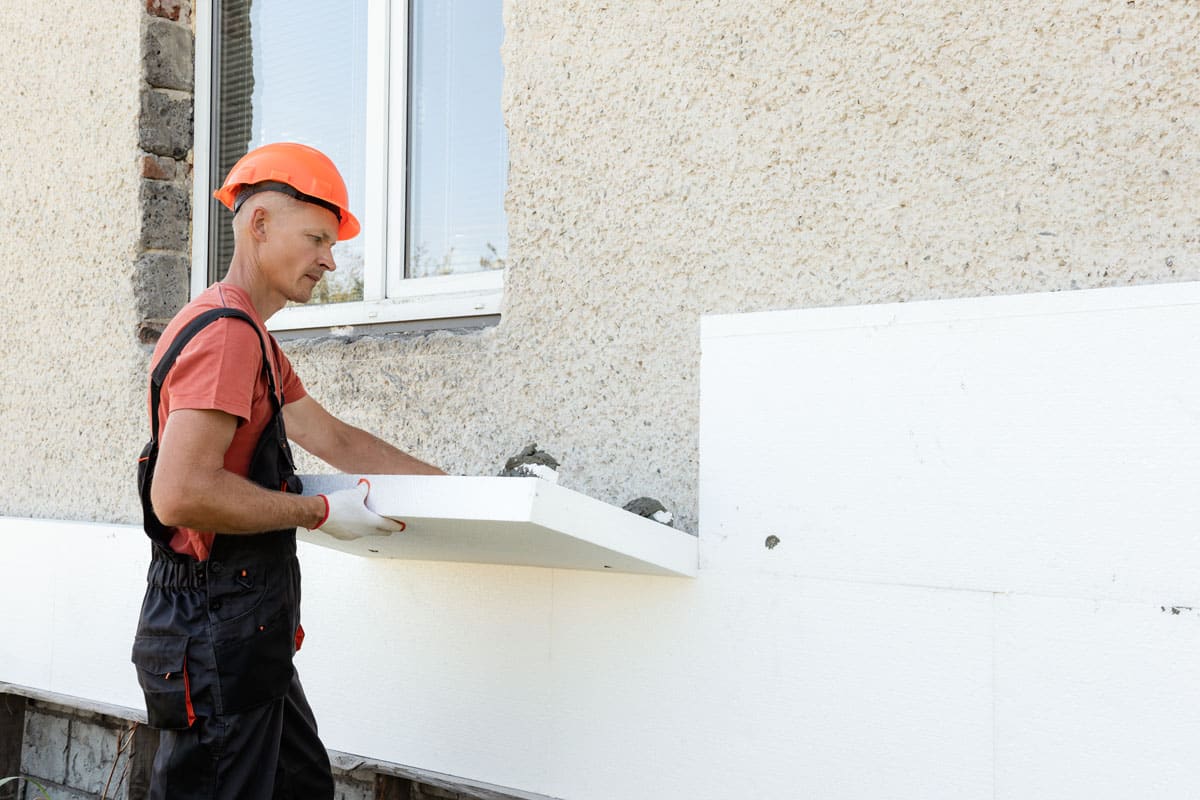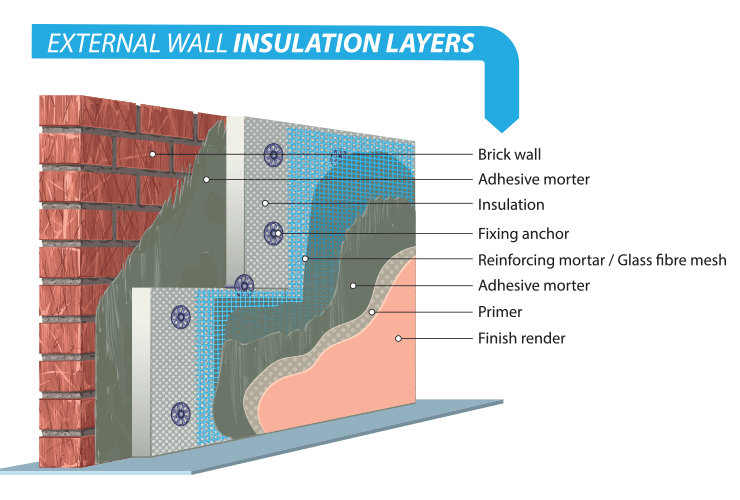External Wall Insulation. Does it Work and is it Worth the Investment?
External wall insulation is just one of many ways you might consider improving the insulation of your property. In this article we will look at whether external wall insulation is likely to be a good investment or not.
What is External Wall Insulation?
External wall insulation is an insulation that is added to the outside of a building. It is a type of solid wall insulation. External wall insulation is sometimes known as EWI for short.
The main alternatives to external wall insulation are internal wall insulation or cavity wall insulation.
External wall insulation is mostly considered for properties with solid walls where cavity wall insulation cannot be installed. Houses built before the 1920s in the UK are most likely to have solid walls.
There are different types of external wall installation including cladding systems and render systems. External wall insulation involves fixing insulation material to the outside wall of a property and then covering it with either render or cladding. A range of different cosmetic finishes are available to either match or change the external appearance of the building.
External wall insulation can add up to 100mm to the thickness of external walls.

Access our selection of exclusive, high-yielding, buy-to-let investment property deals and a personal consultant to guide you through your options.
The Advantages of External Wall Insulation
- External wall insulation should make a property more thermally efficient. It should make the property warmer. Solid walls often have very poor thermal performance.
- External wall insulation should help to save energy. It should help reduce energy bills and help reduce CO2 emissions generated by the property.
- Because external wall insulation is fitted to the outside of a property it will not make the rooms smaller as internal wall insulation does.
- Fitting external wall insulation will not affect the interior of the house as with internal wall insulation. It will not cause disruption or damage during fitting and the interior will not need to be redecorated.
- External wall insulation can also help make external walls more waterproof and windproof. It can also be used to remedy any defects with the outside walls such as spalled brick or stone.
It can also be used to change or improve the external appearance of a property.
- External wall insulation may also act as sound insulation. It may make the inside of the property quieter.

The Disadvantages
- External wall insulation could lead to or exacerbate damp problems in some situations.
- External wall insulation may change or spoil the external appearance of the property.
- Planning permission may be needed to install this kind of insulation. For example, if it significantly changes the appearance of the property or if it is a listed building or in a conservation area. It may not be possible to get planning permission for external wall insulation in some cases.
- External wall insulation can be difficult or even impossible to install on some properties.
Installing external wall insulation will require the removal and replacement of fittings such as external pipework, cables, light fittings and satellite TV dishes.
Installing external wall insulation can be problematic in semi-detached and terraced houses and flats where it is not being installed on neighbouring properties.
- The cost. External wall insulation is likely to be the most expensive type of wall insulation. It is much more expensive than cavity wall insulation and also more expensive than internal wall insulation. The cost of the materials required, the labour, ancillary work, scaffolding and access equipment needed can be considerable.
What does External Wall Insulation Cost?
This will depend on your property, its type and size, the type of external wall insulation used and the amount of work needed to install it. You may install external wall installation to all of the external walls or just some of them,
To find out how much external wall insulation will cost you should take advice from a surveyor or professional installer. They will advise on whether external wall insulation is appropriate for your property or not, what type is most suitable and what the full cost will be.
Average Costs
Trade organisation Checkatrade suggests that external wall insulation usually costs around £100 per square metre. They provide some possible average costs for external wall insulation in different types of properties as follows:
Detached house
From £15,000 +VAT to £20,000 +VAT. Average cost £17,500.
Semi-detached house
From £8,000 +VAT to £10,000 +VAT. Average cost £9,000.
Mid terrace house
From £6,000 +VAT to £8,000 +VAT. Average cost £7,000.

Is it Worth the Investment?
When trying to decide whether external wall insulation is worth the investment there are various things you will need to consider:
- You will need to consider the cost of installing external wall insulation in the first place, based on advice and quotes from specialist installers.
- You will need to consider what grants or other financial support might be available to help with the cost of external wall insulation. These may depend on the type of property in question, the tenure, your personal circumstances, and the location.
Check with your energy supplier or local authority to find out about any grant schemes for external wall insulation.
- You will need to consider what you are trying to achieve as a result of your investment in external wall insulation. This might be saving on heating bills. In this case, it is easier to assess what the financial return on your investment might be. Similarly, a reduction in CO2 emissions is relatively easy to quantify.
Other benefits of external wall insulation such as a warmer property, a quieter property or improved cosmetic appearance are much more difficult to quantify. You may value the warmer, less draughty home that external wall insulation provides, but it is difficult to decide whether that makes it a good investment.
Installing an external wall installation may help to improve the EPC rating of your property. Research by Money Supermarket suggests that there is a correlation between a stronger energy efficiency or EPC rating and a higher house price. So this may help to make external wall installation a better investment.
How Much Can you Save on Energy Bills?
The Energy Saving Trust has published some estimates to indicate how much solid wall insulation (either external wall insulation or internal wall insulation) may save on annual energy bills and on CO2 emissions for average homes.
- In a detached house, solid wall insulation could save £930 on annual energy bills and save 1,600kg of CO2 annually.
- In a semi-detached house, solid wall insulation could save £540 on annual energy bills and save 910kg of CO2.
- In a mid-terrace house, solid wall insulation could save £315 on annual energy bills and save 540kg of CO2.
- In a bungalow, solid wall insulation could save £420 on annual energy bills and save 720kg of CO2.
- In a mid-floor flat solid wall insulation could save £240 on annual energy bills and save 410kg of CO2.
(These savings apply in England, Scotland and Wales and are based on insulating a gas-heated home. The possible savings are slightly lower for Northern Ireland, and are also based on an oil-heated home.)
How Long will it Take to Recover the Cost?
The Energy Saving Trust also estimate that the typical cost of external wall insulation for a typical 3-bedroom semi-detached house is around £12,000.
Based on these estimates it would take around 22.2 years to repay the investment in external wall insulation. This is based on savings in energy bills alone and no other factors, however.
So the answer to the question ‘Is external wall insulation worth the investment?’ is, yes, it can be .... in the longer term. However, it very much depends on the cost of installing an external wall installation in the first place and your energy usage together with any other factors that are important to you.
